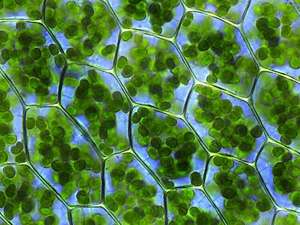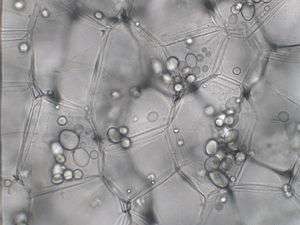கனிகங்கள்
கனிகங்கள் (Plastid) என்னும் சொல் கிரேக்க பிளஸ்டொஸ் (plastós) இருந்து உருவாகியது. பளபளப்பான, ஒரு பெரிய இரட்டை மென்படலம் கொண்ட செல் உள் உறுப்பாக உயிரினங்களில் மத்தியில், குறிப்பாக தாவரங்கள் மற்றும் பாசிகள் செல்கள் காண்ப்படுகின்றன. செல்கள் பயன்படுத்தும் முக்கிய இரசாயன கலவைகள் உற்பத்தி மற்றும் சேமிப்பு தளமாகவும் உள்ளன. அவை பெரும்பாலும் ஒளிச்சேர்க்கைகளில் பயன்படுத்தப்படும் நிறமிகளைக் கொண்டிருக்கின்றன, தற்போதுள்ள நிறமிகளின் வகைகள் கலத்தின் நிறத்தை மாற்றலாம் அல்லது தீர்மானிக்கலாம். அவை ஒரு பொதுவான பரிணாம வளர்ச்சியைக் கொண்டிருக்கின்றன மற்றும் புரோகாரியோடிக் கலங்களைப் போன்ற வட்ட வடிவான இரட்டைப் பிணைந்த டி.என்.ஏ மூலக்கூறை வைத்திருக்கின்றன.

Plant cells with visible chloroplasts.
தாவரகனிகங்கள்

லியுகோபிளாஸ்டிட் in plant cells.
மேற்கோள்கள்
- Sato, N. (2006). "Origin and Evolution of Plastids: Genomic View on the Unification and Diversity of Plastids". In R.R. Wise; J.K. Hoober. The Structure and Function of Plastids. 23. Springer Netherlands. pp. 75–102. ISBN 978-1-4020-4060-3. doi:10.1007/978-1-4020-4061-0_4.
- Kolattukudy, P.E. (1996) "Biosynthetic pathways of cutin and waxes, and their sensitivity to environmental stresses", pp. 83–108 in: Plant Cuticles. G. Kerstiens (ed.), BIOS Scientific publishers Ltd., Oxford
- Wise, Robert R. (2006). "1. The Diversity of Plastid Form and Function". Advances in Photosynthesis and Respiration (PDF). 23. Springer. pp. 3–26. doi:10.1007/978-1-4020-4061-0_1.
- "Plants Without Plastid Genomes | The Scientist Magazine®". The Scientist. Retrieved 2015-09-26.
- Barbrook, Adrian C.; Howe, Christopher J.; Purton, Saul (2006). "Why are plastid genomes retained in non-photosynthetic organisms?". Trends in Plant Science. 11 (2): 101–108. PubMed. doi:10.1016/j.tplants.2005.12.004.
This article is issued from
Wikipedia.
The text is licensed under Creative
Commons - Attribution - Sharealike.
Additional terms may apply for the media files.